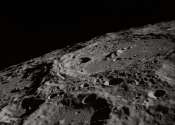Fizzing sodium could explain asteroid Phaethon's cometlike activity
Models and lab tests suggest the asteroid could be venting sodium vapor as it orbits close to the Sun, explaining its increase in brightness.

Models and lab tests suggest the asteroid could be venting sodium vapor as it orbits close to the Sun, explaining its increase in brightness.
Planetary Sciences
Aug 16, 2021
2
954

Researchers from NASA and the Johns Hopkins University Applied Physics Laboratory in Laurel, Maryland, report that streams of meteoroids striking the Moon infuse the thin lunar atmosphere with a short-lived water vapor.
Space Exploration
Apr 15, 2019
2
616

On Oct. 13, 2014 something very strange happened to the camera aboard NASA's Lunar Reconnaissance Orbiter (LRO). The Lunar Reconnaissance Orbiter Camera (LROC), which normally produces beautifully clear images of the lunar ...
Space Exploration
May 26, 2017
0
190

(Phys.org) —The Man in the Moon appeared when meteoroids struck the Earth-facing side of the moon creating large flat seas of basalt that we see as dark areas called maria. But no "face" exists on farside of the moon and ...
Space Exploration
Jun 9, 2014
23
0

Homer's Iliad tells the story of Troy, a city besieged by the Greeks in the Trojan War. Today, a lone robot sits besieged in the sands of Troy while engineers and scientists plot its escape.
Space Exploration
Dec 3, 2009
11
0

(PhysOrg.com) -- The expanding spot discovered on Venus last month may not have garnered as much attention as the meteor impact with Jupiter, but its cause is certainly more puzzling.

A new study published this month in JGR Planets posits that the major particle ejections off the near-Earth asteroid Bennu may be the consequence of impacts by small, sand-sized particles called meteoroids onto its surface ...
Space Exploration
Sep 9, 2020
0
46

On February 1, 2019 a bright meteor crossed the sky over Cuba in the middle of the day. The phenomenon, which was followed by a smoke trail (a characteristic cloud left by the burn in the atmosphere of a meteoroid) and a ...
Space Exploration
Feb 15, 2019
0
60

Because much of the evidence from Earth's early history has been destroyed by plate tectonics and weathering, astronomers often look to the moon and Mars for clues about our beginnings. But what if some of our information ...
Space Exploration
Sep 11, 2018
2
181

Our atmosphere is a better shield from meteoroids than researchers thought, according to a new paper published in Meteoritics & Planetary Science.
Space Exploration
Dec 11, 2017
15
110
A meteoroid is a sand- to boulder-sized particle of debris in the Solar System. The visible path of a meteoroid that enters Earth's (or another body's) atmosphere is called a meteor, or colloquially a shooting star or falling star. If a meteoroid reaches the ground and survives impact, then it is called a meteorite. Many meteors appearing seconds or minutes apart are called a meteor shower. The root word meteor comes from the Greek meteo¯ros, meaning "high in the air". The Minor Planet Center does not use the term "meteoroid".
This text uses material from Wikipedia, licensed under CC BY-SA